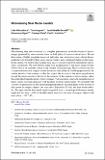| dc.contributor.author | Weisenbach, Luke | |
| dc.contributor.author | Anguita, Timo | |
| dc.contributor.author | Miralda-Escudé, Jordi | |
| dc.contributor.author | Oguri, Masamune | |
| dc.contributor.author | Saha, Prasenjit | |
| dc.contributor.author | Schechter, Paul L. | |
| dc.date.accessioned | 2024-08-05T18:37:27Z | |
| dc.date.available | 2024-08-05T18:37:27Z | |
| dc.date.issued | 2024-07-30 | |
| dc.identifier.uri | https://hdl.handle.net/1721.1/155945 | |
| dc.description.abstract | Microlensing near macro-caustics is a complex phenomenon in which swarms of micro-images produced by micro-caustics form on both sides of a macro-critical curve. Recent discoveries of highly magnified images of individual stars in massive galaxy cluster lenses, predicted to be formed by these micro-image swarms, have stimulated studies on this topic. In this article, we explore microlensing near macro-caustics using both simulations and analytic calculations. We show that the mean total magnification of the micro-image swarms follows that of an extended source in the absence of microlensing. Micro-caustics join into a connected network in a region around the macro-critical line of a width proportional to the surface density of microlenses; within this region, the increase of the mean magnification toward the macro-caustic is driven by the increase of the number of micro-images rather than individual magnifications of micro-images. The maximum achievable magnification in micro-caustic crossings decreases with the mass fraction in microlenses. We conclude with a review of applications of this microlensing phenomenon, including limits to the fraction of dark matter in compact objects, and searches of Population III stars and dark matter subhalos. We argue that the discovered highly magnified stars at cosmological distances already imply that less than ∼ 10% of the dark matter may be in the form of compact objects with mass above ∼10−6 𝑀⊙. | en_US |
| dc.publisher | Springer Netherlands | en_US |
| dc.relation.isversionof | 10.1007/s11214-024-01088-9 | en_US |
| dc.rights | Creative Commons Attribution | en_US |
| dc.rights.uri | https://creativecommons.org/licenses/by/4.0/ | en_US |
| dc.source | Springer Netherlands | en_US |
| dc.title | Microlensing Near Macro-Caustics | en_US |
| dc.type | Article | en_US |
| dc.identifier.citation | Weisenbach, L., Anguita, T., Miralda-Escudé, J. et al. Microlensing Near Macro-Caustics. Space Sci Rev 220, 57 (2024). | en_US |
| dc.contributor.department | MIT Kavli Institute for Astrophysics and Space Research | |
| dc.relation.journal | Space Science Reviews | en_US |
| dc.identifier.mitlicense | PUBLISHER_CC | |
| dc.eprint.version | Final published version | en_US |
| dc.type.uri | http://purl.org/eprint/type/JournalArticle | en_US |
| eprint.status | http://purl.org/eprint/status/PeerReviewed | en_US |
| dc.date.updated | 2024-08-04T03:14:05Z | |
| dc.language.rfc3066 | en | |
| dc.rights.holder | The Author(s) | |
| dspace.embargo.terms | N | |
| dspace.date.submission | 2024-08-04T03:14:05Z | |
| mit.license | PUBLISHER_CC | |
| mit.metadata.status | Authority Work and Publication Information Needed | en_US |
